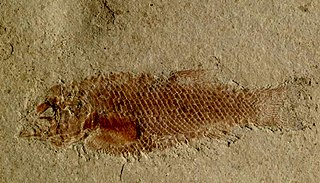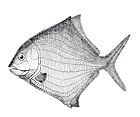
Dictyopyge is an extinct genus of prehistoric freshwater ray-finned fish that inhabited eastern North America during the early part of the Late Triassic. Two species are recognized, both from the early Carnian-aged Doswell Formation in what is now Virginia, United States:
Agecephalichthys is an extinct genus of prehistoric freshwater "palaeonisciform" ray-finned fish that lived during the Anisian age. It contains a single species, A. granulatus from the Hawkesbury Sandstone in what is now New South Wales, Australia.
Neuburgella is an extinct genus of prehistoric bony fish that lived during the Cisuralian epoch in what is now Kazakhstan.

Sinoniscus is an extinct genus of prehistoric bony fish that lived during the Late Permian epoch.
Inichthys is an extinct genus of prehistoric marine bony fish that lived during the Lopingian epoch. Fossils were recovered in the Kuznetsk Basin, European Russia.
Tienshaniscus is an extinct genus of prehistoric bony fish that lived during the Lopingian epoch in what is now Xinjiang, China.
Trachelacanthus is an extinct genus of prehistoric bony fish that lived during the Late Permian epoch.

Paraceratodus is an extinct genus of prehistoric lungfish. Only one species, P. germaini, is known from the latest Permian or earliest Triassic period of Madagascar. Phylogenetic evidence supports it being the most basal member of the suborder Ceratodontoidei, which contains modern lungfish, and as with the rest of the order it likely diverged during the late Carboniferous.

Acentrophorus is an extinct genus of prehistoric freshwater and marine ray-finned fish from the Roadian to the Wuchiapingian of England, Germany (Kupferschiefer), Italy and Russia. There may also be a Triassic occurrence in Australia.
Isadia is an extinct genus of prehistoric freshwater ray-finned fish from the order Eurynotoidiformes. It is known from the Permian of European Russia. The genus Amblypterina is partially considered a junior synonym of both Isadia and Kichkassia.

Bobasatrania is an extinct genus of prehistoric marine ray-finned fish that survived the Permian-Triassic extinction event. Fossils of Bobasatrania were found in beds of Changhsingian to Ladinian age. It was most speciose during the Early Triassic.
Boreolepis is an extinct genus of prehistoric marine ray-finned fish that lived from the Late Kungurian to the Wuchiapingian of the Permian period. It inhabited the high northern latitudes in what is now Greenland and European Russia.
Cycloptychius is an extinct genus of prehistoric freshwater & marine ray-finned fish that existed throughout much of the Carboniferous period in Eurasia, and possibly into the Early Permian in South Africa. It was a member of the Rhadinichthyidae, a family of basal ray-finned fish that was formerly placed in the now-paraphyletic order Palaeonisciformes.
Urosthenes is an extinct genus of prehistoric bony fish that lived during the Lopingian to Middle Triassic epochs in what is now New South Wales, Australia.
Eurynotoides is an extinct genus of prehistoric bony fish in the family Eurynotoididae of the order Eurynotoidiformes.
Eigilia is an extinct genus of prehistoric freshwater ray-finned fish that lived during the Roadian age in what is now Kazakhstan. It is known from the Verka Formation.
Korutichthys is an extinct genus of prehistoric marine bony fish that lived during the Lopingian epoch in what is now Krasnoyarsk Krai, Russia. It was first referred to the family Amblypteridae, a view that was later questioned.
Igornella is an extinct genus of prehistoric bony fish that lived during the Gzhelian (Stephanian) to Asselian ages in what is now France (Burgundy).
Gardinerpiscis is an extinct genus of prehistoric actinopterygian fish that lived during the Kungurian age of the early Permian epoch in what is now Kazakhstan. It was originally named "Gardineria" by Kazantseva-Selezneva (1981). Because this genus name was already given to an extant scleractinian coral, the new name Gardinerpiscis was erected for the Permian fish. The genus includes a single species (monotypy): Gardinerpiscis akkolkensis.
Turseodus is an extinct genus of ray-finned fish found in Late Triassic freshwater sediments of the United States. Two species have been described, T. acutus from the Lockatong Formation of Pennsylvania, and T. dolorensis from the Chinle Formation of Colorado.














